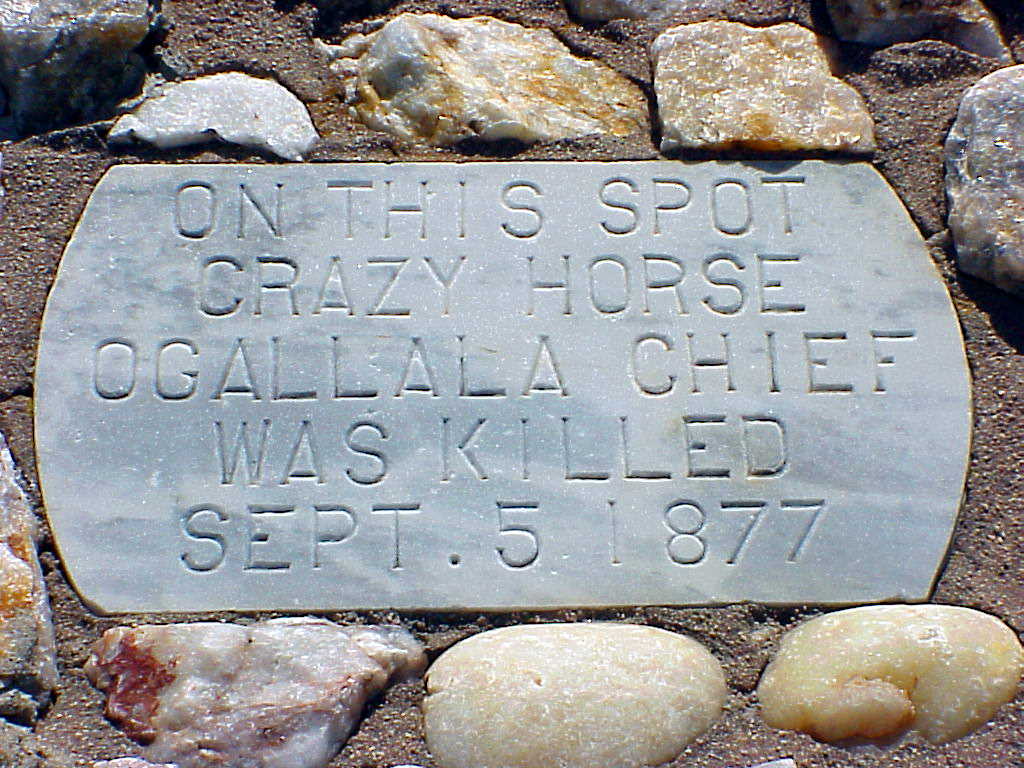Powers, Thomas. The Killing of Crazy Horse, Alfred A. Knopf, New York, 2011 (568pp.$30)
The great Oglala Sioux warrior Crazy Horse, leader of the Hunkpatila band comprising some 150 lodges and perhaps 400 men, women and children—Thunder Dreamer, Carrier of the Shield, killer of Custer the Genocidal Buffoon—was murdered by a veteran soldier of the Mormon Wars named William Gentles, who, according to the contemporary evidence offered by He Dog, stabbed Crazy Horse in the back with a bayonet as he was being shoved into a jail cell at Fort Robinson, Nebraska Territory, on September 5, 1877
Several hundred people were on the parade ground of Robinson that day, agency Indians, sometimes called Loafers, soldiers, soldiers’ wives, officers and scouts, many hostile to Crazy Horse, some merely confused Indians trying to please the whites. The event is as tragic as the assassination of Lincoln and Martin Luther King, who were themselves warriors of another kind, but attacked and finally destroyed by the great awful growling maw of American history.
There has never been a better book written about these events: the Sioux wars of the 1860s and 1870s from the time of the Box Elder Fight and the Fetterman Massacres along the Bozeman Trail just after the Civil War, through the final stand of the Sioux in their best and last hunting country on the Tongue and Powder Rivers just south of the Yellowstone country, now northern Wyoming. Powers, a historian of the intelligence community with many books to his credit, explains in the introduction to this magical, authoritative, detailed and moving account that a “child’s sympathies develop early and mine were with the Indians.”
And there has never been a better book personalizing the people involved—the Sioux themselves presented as individuals in all their complexity: the half-Sioux interpreter William Garnett, who was present at all the major events and heard the Indians speak, Lt.William Philo Clark who in his capacity as go-between to the Indians at Robinson emerges as the only honest man among the American solidiers, including Luther P. Brandley, commander of Fort Robinson, and General George Crook, Indian Fighter Deluxe, both liars and hypocrites.
Crazy Horse was not the last wild Indian. Sitting Bull had gone to Canada with his people, seeking the protection of the Great Mother in England. There were a few small bands of Brule hiding in creek bottoms somewhere in Wyoming, even after Crazy Horse “came in” during the hungry spring of 1877.
But Crazy Horse was iconic. According to powers, Horn Chips said that in preparing for a fight, Crazy Horse painted his face red with earth, making a zigzag streak from the top of his forehead down one side of his nose to his chin. He painted his face with hail spots, dipping his fingers in white paint, touching himself here and there. he wore a medicine bundle around his neck and sometimes the dried body of a red-tailed hawk attached to his hair at the outside of his temple, and one or two eagle feathers as well. Sometimes he covered himself with the hide of a colt. Amos Bad Heart Bull, He Dog and Short Bull—each portrayed Crazy Horse as painted yellow in battle, with hail spots on his face and body, his horse streaked with lightning bolts and covered with a soft powder of dust gathered from around gopher holes, dust which rendered the horse invisible.
Because of his intransigence and power, Crazy Horse became the object of jealousy by agency Indians, especially chiefs like Red Cloud and Spotted Tail, who had brought their Oglala and Brule people to the agency a decade earlier. And because Crazy Horse had led the tribes against Custer, wiping out the famous Seventh Cavalry, the Americans lusted for revenge against him. They got what they wished. The Oglala in Crazy Horses’s band, then camped along Chadron Creek about 40 miles northeast of Robinson, took his body away and secreted it. It was never found.
Powers uses his considerable skills to highlight the precise political upheavals within the tribes and bands that led to turmoil at Robinson. Scouts—some Oglala themselves, but most Crow or Shoshone, traditional enemies of the Sioux—become familiar to the reader.
Even Crook himself, stolid, vain, imperious and ultimately a failed cipher, jumps off Powers’ pages, as do his many underlings, pages, squires and toadies, as well as the journalists form Chicago and Philadelphia who were camp followers.
By the end, we feel inclined to treat these characters as living beings. No other book of Western history (and there are very many) achieves so much from the historical record. Thunder Dreamers like Crazy Horse did not hide form storms that on the prairie often killed animals and people. They split the storm, explained Kicking Bear. James Bordeaux, another grader who knew the Indians who knew Crazy Horse, said that inside the medicine bundle carried by the great warrior was a wild aster mixed with the dried heart and brain of an eagle. Horn Chips told everyone that Crazy Horse wore a blue-painted rock on a thong around his left ear, symbolic of hail, and that he rallied his comrades by blowing on a whistle made from the wing bone of an eagle.
There are no photographs of Crazy Horse. He refused to travel to Washington and become a laughingstock. He never signed a treaty or ever believed a single word the Americans said. He stayed with the life until his people were starved. Crazy Horse rode at the front in battle, unlike American generals who stayed safely at the rear. In life, he prepared himself for death, and among the Sioux at Pine Ridge he is still mourned.


